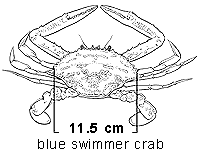Blue swimmer crab fishery
Blue swimmer crabs are also known as sand crabs.
Fishery symbol
- C1: Other than spanner crabs
Management
Operating area
Quota
The fishery is managed through:
- individual transferable quotas (ITQs) units allocated to each primary commercial fishing licence
- management region: BC1 – blue swimmer crab (all of Queensland)
A licence holder must have sufficient unused quota for the blue swimmer crab management region before they are allowed to fish in that region.
The trawl fishery are also permitted to by-product the species, but are limited to 10% allocation of the total TAC.
Licences
To operate in the commercial crab fishery, you need a:
- commercial fisher licence for the person in charge of fishing activities
- primary commercial fishing licence with the relevant fishery symbol.
Reporting and monitoring
Commercial crab fishers must:
- report trip and catch notices
- complete daily logbooks
- keep sale dockets
- have vessel tracking on their boats
- comply with state marine park and Great Barrier Reef Marine Park zoning rules.
Closures
- None apply
Equipment
The fishing gear allowed depends on how many C1 symbols are attached to the primary commercial fishing licence.
When the symbol appears:
- once: maximum of 50 pots, collapsible traps or dillies can be used at the same time
- twice: maximum of 100 pots, collapsible traps or dillies can be used at the same time
- three times: maximum of 150 pots, collapsible traps and dillies can be used at the same time.
No more than 100 pots, collapsible traps or dillies may be used at the same time to take crabs in the Hervey Bay crab area or Moreton Bay crab area.
Crab apparatus must be checked at least every 7 days after being set.
Pots
Crab pots must have prescribed escape vents, either:
- large rectangular escape vent: means a rectangular opening in an item of crab apparatus that is at least 120mm long and 50mm wide
- round escape vent: means a round opening in an item of crab apparatus that has a diameter of at least 105mm.
Trotlines
Fishers can fish using pots arranged along a trotline (excluding some areas):
- no more than 10 pots are permitted on a single line
- you must mark the trotlines with a prescribed buoy and flagpole.
Dillies
A dilly must have:
- an area within its frame of no more than 1m2
- and
- a net drop below its frame of no more than 10cm.
A dilly's net must have:
- only 1 layer of mesh and each mesh in the layer must be square or rectangular
- a mesh size of at least 25mm.
Take and size limits
- It is prohibited to take female blue swimmer crabs – they must be immediately returned to the water
- Minimum length of 11.5cm across widest part of its carapace (notch to notch).
